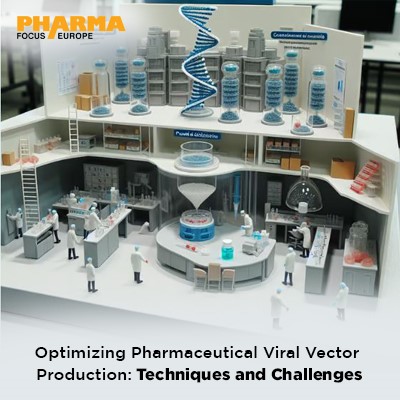
This article explores techniques and challenges in optimizing pharmaceutical viral vector production for gene therapy and vaccine development. Topics include vector design, cell culture, purification, and quality control, along with strategies like cell line engineering, bioprocess optimization, and AI integration. Future trends and innovations are also discussed.

Pharmaceutical viral vectors have emerged as powerful tools in gene therapy, vaccine development, and biotechnology research. The ability of viral vectors to deliver genetic material into target cells with high efficiency has revolutionized the field of medicine. However, the production of viral vectors at scale presents numerous challenges that must be addressed to ensure their efficacy, safety, and cost-effectiveness. This article explores the techniques and challenges involved in optimizing pharmaceutical viral vector production.
I. Overview of Viral Vector Production
Viral vectors are typically derived from naturally occurring viruses that have been modified to carry therapeutic genes or vaccine antigens. The production of viral vectors involves several key steps, including vector design, cell culture, vector production, purification, and quality control.
Vector Design: The first step in viral vector production is designing the vector construct. This involves selecting the appropriate viral backbone, modifying it to carry the desired genetic material, and incorporating regulatory elements to control gene expression.
Cell Culture: Once the vector construct is designed, it is introduced into host cells for replication. Cell culture techniques play a crucial role in viral vector production, as they determine the yield, purity, and quality of the vectors.
Vector Production: During vector production, the host cells are infected with the vector construct, leading to the production of viral particles containing the therapeutic genes or antigens.
Purification: The next step involves purifying the viral vectors from the cell culture supernatant or lysate. Purification techniques such as chromatography, ultracentrifugation, and filtration are used to remove cellular debris, contaminants, and empty viral particles.
Quality Control: Finally, the purified viral vectors undergo rigorous quality control tests to ensure their safety, potency, and stability. These tests include assessing vector titer, purity, integrity, and bioactivity.
II. Techniques for Optimizing Viral Vector Production
Optimizing viral vector production involves maximizing vector yield, improving vector purity, enhancing vector stability, and reducing production costs. Several techniques and strategies can be employed to achieve these goals:
Cell Line Engineering: Selecting the right host cell line is critical for viral vector production. Cell line engineering techniques, such as cell line optimization, gene editing, and cell line immortalization, can improve cell productivity, vector yield, and vector quality.
Bioprocess Optimization: Optimizing the bioprocess parameters, such as cell culture media, cell density, infection conditions, and harvest timing, can significantly enhance viral vector production efficiency. Process analytical technologies (PAT) and data-driven approaches can aid in optimizing bioprocess parameters.
Transient Transfection: Transient transfection techniques allow for the rapid production of viral vectors without the need for stable cell lines. This approach is particularly useful for early-stage research, process development, and small-scale production.
Virus Harvest and Purification: Developing robust virus harvest and purification protocols is essential for obtaining high-quality viral vectors. Integration of single-use technologies, continuous processing, and automated purification systems can streamline the purification process and improve vector purity.
Quality by Design (QbD): Implementing a QbD approach involves designing viral vector production processes with predefined quality objectives. QbD principles focus on understanding process variability, risk assessment, and continuous improvement to ensure consistent and reproducible vector production.
III. Challenges in Viral Vector Production
Despite the advancements in viral vector production techniques, several challenges persist:
Scalability: Scaling up viral vector production from laboratory-scale to commercial-scale remains a major challenge. Issues such as maintaining cell line stability, optimizing bioreactor performance, and ensuring batch-to-batch consistency need to be addressed for large-scale production.
Vector Immunogenicity: Viral vectors can elicit immune responses in host cells, leading to reduced vector efficacy and safety concerns. Strategies to minimize vector immunogenicity, such as capsid engineering, immune modulation, and vector masking, are actively being explored.
Regulatory Compliance: Meeting regulatory requirements for viral vector production, including Good Manufacturing Practices (GMP), process validation, and product characterization, is crucial for obtaining regulatory approval and commercialization.
Cost Considerations: The cost of viral vector production, including raw materials, labor, facility costs, and quality control, can be significant. Developing cost-effective production strategies, such as process intensification, supply chain optimization, and technology transfer, is essential for commercial success.
Vector Stability and Storage: Ensuring the long-term stability and storage of viral vectors is essential for their shelf life and therapeutic efficacy. Stability studies, formulation optimization, and cold chain management are key areas of focus to address vector stability challenges.
IV. Future Trends and Innovations
The field of pharmaceutical viral vector production is constantly evolving, with several trends and innovations shaping its future:
Advanced Cell Engineering: Advances in cell engineering technologies, such as CRISPR/Cas9 gene editing, synthetic biology, and cell-free systems, are enhancing host cell performance and vector yield.
Next-Generation Purification Technologies: The development of novel purification technologies, including affinity chromatography, membrane-based filtration, and microfluidic devices, is improving vector purity, yield, and process efficiency.
Integrated Process Development Platforms: Integrated process development platforms, combining cell line engineering, bioprocess optimization, and analytics, are enabling rapid and cost-effective viral vector production from concept to commercialization.
AI and Data Analytics: The integration of artificial intelligence (AI) and data analytics tools for process monitoring, optimization, and predictive modeling is driving efficiency, scalability, and quality in viral vector production.
Gene Editing for Vector Safety: Incorporating gene editing technologies, such as site-specific integration and gene silencing, can enhance vector safety, reduce immunogenicity, and improve therapeutic outcomes.
Optimizing pharmaceutical viral vector production is essential for advancing gene therapy, vaccine development, and biotechnology applications. By leveraging innovative techniques, addressing key challenges, and embracing future trends, researchers and manufacturers can achieve scalable, cost-effective, and high-quality viral vector production for transformative healthcare solutions.